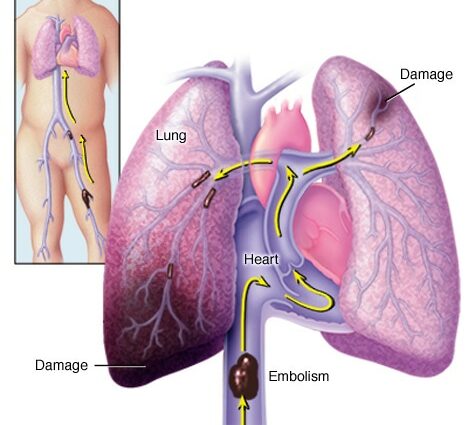Contents
Pulmonary embolism
What is pulmonary embolism?
A pulmonary embolism is the obstruction of one or more arteries supplying the lungs. This blockage is most often caused by a blood clot (phlebitis or venous thrombosis) that travels to the lungs from another part of the body, very often from the legs.
Pulmonary embolism can occur in healthy people.
Pulmonary embolism can be extremely dangerous to your health. Prompt treatment with anti-coagulant drugs can significantly reduce the risk of death.
Causes of pulmonary embolism
A blood clot that forms in a deep vein in a leg, pelvis, or arm is called deep vein thrombosis. When this clot or part of this clot travels through the bloodstream to the lungs, it can block the pulmonary circulation, this is called a pulmonary embolism.
Occasionally, a pulmonary embolism can be caused by fat from the bone marrow of a broken bone, air bubbles, or cells from a tumor.
How to diagnose it?
In people with lung disease or cardiovascular disease, it may be difficult to identify the presence of pulmonary embolism. A series of tests, including blood tests, a chest x-ray, a lung scan, or a CT scan of the lungs can help identify the cause of symptoms.
Symptoms of pulmonary embolism
- Severe chest pain, which may look like symptoms of a heart attack and which persists despite rest.
- Sudden shortness of breath, difficulty breathing, or wheezing, which may occur at rest or during exertion.
- Cough, sometimes with blood-stained sputum.
- Excessive sweating (diaphoresis).
- Swelling usually in one leg.
- A weak, irregular or very fast pulse (tachycardia).
- A blue coloration around the mouth.
- Dizziness or fainting (loss of consciousness).
Complications possbiles
When the blood clot is large, it can block blood flow to the lungs. Pulmonary embolism can lead to:
- The death.
- Permanent damage to the affected lung.
- Low blood oxygen level.
- Damage to other organs due to lack of oxygenation.
People at risk of pulmonary embolism
Older people are more at risk of developing blood clots because of:
– degradation of valves in the veins of the lower limbs, which ensure adequate blood circulation in these veins.
– dehydration which can thicken the blood and cause clots.
– other medical problems, such as cardiovascular disease, cancer, surgery or joint replacement (replacement of a joint). Women and men who have already developed blood clots or deep vein thrombosis (phlebitis).
People with a family member who has already developed blood clots. An inherited disease can be the cause of some blood clotting disorders.
Prevent embolism
Why prevent? |
Most people recover from a pulmonary embolism. However, a pulmonary embolism can be extremely dangerous and can lead to death if not taken care of immediately. |
Can we prevent? |
Preventing the formation of blood clots, mainly in the legs, remains one of the main measures to prevent pulmonary embolism. |
Basic preventive measures |
Prolonged inactivity can cause blood clots to form in the legs.
People admitted to hospital for a heart attack, stroke, complications from cancer, or burns may be at risk for blood clots. Anticoagulant therapy, such as an injection of heparin, can be given as a preventive measure. |
Measures to prevent recurrence |
In some people who are at risk for complications or recurrence of pulmonary embolism, a filter may be placed in the inferior vena cava. This filter helps prevent the progression of clots formed in the veins of the lower limbs to the heart and lungs. |










